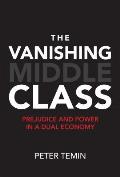“The Vanishing Middle Class: Prejudice and Power in a Dual Economy” by Peter Temin
 Synopsis from Powells.com–
Synopsis from Powells.com–
The United States is becoming a nation of rich and poor, with few families in the middle. In this book, MIT economist Peter Temin offers an illuminating way to look at the vanishing middle class. Temin argues that American history and politics, particularly slavery and its aftermath, play an important part in the widening gap between rich and poor. Temin employs a well-known, simple model of a dual economy to examine the dynamics of the rich/poor divide in America, and outlines ways to work toward greater equality so that America will no longer have one economy for the rich and one for the poor.
Many poorer Americans live in conditions resembling those of a developing country — substandard education, dilapidated housing, and few stable employment opportunities. And although almost half of black Americans are poor, most poor people are not black. Conservative white politicians still appeal to the racism of poor white voters to get support for policies that harm low-income people as a whole, casting recipients of social programs as the Other — black, Latino, not like us. Moreover, politicians use mass incarceration as a tool to keep black and Latino Americans from participating fully in society. Money goes to a vast entrenched prison system rather than to education. In the dual justice system, the rich pay fines and the poor go to jail.
Review by Yossarian Johnson, The Intellectualist, Dec 2018
“America divided” – this concept increasingly graces political discourse in the U.S., pitting left against right, conservative thought against the liberal agenda. But for decades, Americans have been rearranging along another divide, one just as stark if not far more significant – a chasm once bridged
America divided – this concept increasingly graces political discourse in the U.S., pitting left against right, conservative thought against the liberal agenda. But for decades, Americans have been rearranging along another divide, one just as stark if not far more significant – a chasm once bridged by a flourishing middle class.
Peter Temin, Professor Emeritus of Economics at MIT, believes the ongoing death of “middle America” has sparked the emergence of two countries within one, the hallmark of developing nations.
In his new book, The Vanishing Middle Class: Prejudice and Power in a Dual Economy, Temin paints a bleak picture where one country has a bounty of resources and power, and the other toils day after day with minimal access to the long-coveted American dream.
In his view, the United States is shifting toward an economic and political makeup more similar to developing nations than the wealthy, economically stable nation it has long been.
Temin applied W. Arthur Lewis’s economic model – designed to understand the workings of developing countries – to the United States in an effort to document how inequality has grown in America.
The parallels are unsettling. As noted by the Institute for New Economic Thinking: In the Lewis model of a dual economy, much of the low-wage sector has little influence over public policy. Check*. The high-income sector will keep wages down in the other sector to provide cheap labor for its businesses.* Check*. Social control is used to keep the low-wage sector from challenging the policies favored by the high-income sector.* Mass incarceration – check*. The primary goal of the richest members of the high-income sector is to lower taxes.* Check*. Social and economic mobility is low.* Check*.*
Temin describes multiple contributing factors in the nation’s arrival at this place, from exchanging the War on Poverty for the War on Drugs to money in politics and systemic racism. He outlines the ways in which racial prejudice continues to lurk below the surface, allowing politicians to appeal to the age old “desire to preserve the inferior status of blacks”, encouraging white low-wage workers to accept their lesser place in society.
“We have a structure that predetermines winners and losers. We are not getting the benefits of all the people who could contribute to the growth of the economy, to advances in medicine or science which could improve the quality of life for everyone – including some of the rich people,” he laments.
The antidote, as prescribed by Temin, is likely a tough sell in today’s political climate. Expanding education, updating infrastructure, forgiving mortgage and student loan debt, and overall working to boost social mobility for all Americans are bound to be seen as too liberal by many policy makers. Until the course is changed, he warns, the middle class will continue to fade and America will remain unsustainably divided.












